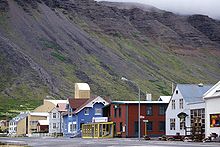Ísafjörður
| Ísafjörður | ||
|---|---|---|
|
|
||
| Coordinates | 66 ° 5 ′ N , 23 ° 7 ′ W | |
| Basic data | ||
| Country | Iceland | |
| Vestfirdir | ||
| ISO 3166-2 | IS-4 | |
| local community | Ísafjarðarbær | |
| Residents | 2703 (January 1, 2019) | |
Ísafjörður ([ ˈiːsaˌfjœrðʏr̥ ]; "Icefjord") is a town in the extreme northwest of Iceland in the municipality of Ísafjarðarbær .
On January 1, 2019, 2703 people lived in Ísafjörður. The city is the administrative seat of the municipality Ísafjarðarbær with 3800 inhabitants (as of January 1, 2019).
geography
Ísafjörður is located on Skutulsfjörður , a tributary of Ísafjarðardjúp , framed by the steep mountain slopes of Eyrarfjall (up to 731 m ) and Kirkjubólsfjall (up to 832 m ) . The city forms the economic and administrative center of the Westfjords .
The sandbar (isl. Eyri ) that supports the place has been raised again and again to create new territory. Thus, the area of the city has continuously increased, the peninsula now almost stretches from one bank of the fjord to the other, creating an effectively protected harbor.
history
The first settler in Landnámabók is Helgi Hrólfsson , who came to this place around 920 and gave the fjord Skutulsfjörður its name when he found a harpoon (isl. Skutull ) on the beach at this point .
In the 16th century , German and English companies established their trading branches here. The houses built during the Danish trade monopoly on the southern tip of the peninsula now form the Neðstikaupstaður local history museum . They represent the oldest surviving settlement core of Iceland ( Krambúð - 1757; Faktorhús - 1765; Tjöruhúsið - 1781; Turnhúsið - 1784).
Ísafjörður's general prosperity only came with clipfish processing in the 18th century .
1787 was Isafjordur to trading center, in 1866 the town was granted the town charter .
Culture and sights
There is a music school in Ísafjörður. Opposite the new hospital, the former hospital now houses a cultural center with a library and exhibition rooms. In the Aðalstræti ( Eng . "Main Street") is the Slunkariki art gallery , where works by international and Icelandic artists are shown. Also worth seeing is the idiosyncratic, ocher-colored concrete church (completed in 1995) and the adjoining cemetery. Located at the eastern mouth of the Skutulsfjörður , the red and yellow lighthouse Arnarnesviti is only about five meters high and was built in 1902.
Economy and Infrastructure
Industry
Ísafjörður was once the largest shrimp fishing site in Iceland and is still famous for its fishing.
Transport links
From June to August there are boat connections from Ísafjörður to the almost completely deserted and difficult to reach Hornstrandir peninsula (nature reserve) on the other side of Ísafjarðardjúp . For several years now, cruise ships have been docking in the port between May and early September. A total of almost fifty calls are planned for 2020, including the German-speaking providers AIDA , Phoenix Reisen and TUI Cruises .
The importance of the place in terms of transport and supply is particularly evident through the connection to the domestic Icelandic flight network; the airfield of Isafjordur is located on the city opposite shore of the fjord.
The distance to the capital Reykjavík is 457 kilometers by road, the nearest town Bolungarvík is about 15 kilometers to the northwest.
education
The regional library was founded in 1889, and Iceland's first music school followed in 1911. Since 1970, Isafjörður has had a high school in addition to the primary school. An art school by the name of Iceland's first architect, Rögnvaldur Ólafsson, was founded in 1993.
In March 2005, a higher education center, Háskólasetur Vestfjarða , was established as the only higher education institution in the region. The university center offers English-language master’s courses (Coastal Communities and Regional Development and Coastal and Marine Management), distance learning courses and international summer schools. In addition, there are several Icelandic courses for different levels each year.
Personalities
Born in Ísafjörður:
- Pétur Sigurgeirsson (1919–2010), bishop
- Jón Laxdal Halldórsson (1933–2005), actor and director
- Jón Baldvin Hannibalsson (* 1939), politician
- Ólafur Ragnar Grímsson (* 1943), President of Iceland 1996–2016
- Guðjón A. Kristjánsson (1944–2018), politician
- Þórhildur Þorleifsdóttir (* 1945), director, actress and politician
- Agnes M. Sigurðardóttir (* 1954), bishop
- Arna Albertsdóttir (* 1990), handbiker
The writer Guðmundur Gíslason Hagalín (1898–1985) was temporarily a city councilor in Ísafjörður.
Town twinning
-
 Joensuu , Finland
Joensuu , Finland -
 Linkoping , Sweden
Linkoping , Sweden -
 Nanortalik , Greenland
Nanortalik , Greenland -
 Roskilde , Denmark
Roskilde , Denmark -
 Skáli , Faroe Islands
Skáli , Faroe Islands -
 Tonsberg , Norway
Tonsberg , Norway -
 Kaufering , Germany
Kaufering , Germany
Sports
Every year at the end of April / beginning of May, the Fossavatn Ski Marathon has been held in Ísafjörður since 1935, an open cross-country skiing competition that has been part of the Worldloppet since 2014 .
The European mud football championship has been held in Ísafjörður every year since 2006 at the end of July / beginning of August.
Web links
- Map of Ísafjörður and the surrounding area from 1913, GeoGreif, Geographical Collections of the University of Greifswald
- Official homepage, English
- Háskólasetur Vestfjarða
Individual evidence
- ↑ Byggðarsafn Vestfjarða (Museum of Local History of the Westfjords). In: www.nedsti.is/. Retrieved January 10, 2017 .
- ↑ Bókasafnið Ísafirði | Saga safnsins. In: Safnahúsið Ísafirði. Retrieved July 30, 2016 .
- ↑ Tónlistarskóli Ísafjarðar | Kynning. Retrieved July 30, 2016 .
- ↑ Menntaskólinn á Ísafirði / Almennt um MÍ. In: www.misa.is. Retrieved July 30, 2016 .
- ↑ Listaskóli Rögnvaldar Ólafssonar | LRÓ. In: www.edinborg.is. Retrieved July 30, 2016 .
- ↑ Háskólasetrið. Retrieved July 30, 2016 (is-IS).
- ↑ http://www.fossavatn.com/
- ↑ http://www.myrarbolti.com/english/





